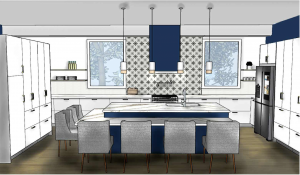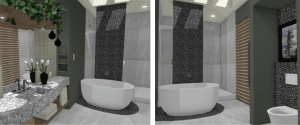Aspiring designers shine in the “Sky’s The Limit!” challenge. By Dianne M. Pogoda
NKBA’s annual Student Design Competition was a fantasy project this year, and the 300-plus entries reflected an unbound creative streak in the aspiring designers.
The Student Design Competition, open to NKBA student members enrolled in an educational institution at the time of submission, was generously sponsored by Cambria. Designers were required to specify Cambria products for their kitchen and bath projects. NKBA Students of the Industry, the NKBA student member program that provides free membership to students, is generously underwritten through Platinum sponsorships from Sub-Zero Wolf Cove and Moen. Sub-Zero Wolf Cove also sponsors student chapters at NKBA’s 150 Affiliated Schools across the U.S. and Canada.
To prepare their projects, students were charged with creating a kitchen and/or bath for imaginary clients in the “Sky’s the Limit” Challenge: Howard and Tracy Redding, newlyweds in their early 30s, who live in a suburb of San Francisco. Howard works as a software developer in the tech industry while Tracy teaches yoga at a local studio a few blocks away. Howard prefers modern, clean lines while Tracy likes lots of texture, with earthy elements like natural stone and wood. Howard is fascinated with all aspects of smart-home technology and is looking to incorporate it into both spaces, while Tracy wants a beautiful, functional design.
Award winners receive complimentary registration to KBIS 2020, admission to the awards ceremony, hotel accommodations and airfare. In addition, 1st place in each category earns a $5,000 scholarship, 2nd place wins a $2,500 scholarship, and 3rd place takes home a $1,000 scholarship.
Judges for the competition, all returning from last year, included Mac Junker, CKBD, a designer for The Kitchen Specialist in Durham, N.C.; Danielle Burger, CMKBD, owner of Kitchen Vitality Design in Charlotte, N.C, and Mark Haddad, CKBD, president of Interiology Design Co. in Watertown, Mass.
“We certainly saw a lot of potential in these entries,” said Junker.
Haddad noted that many of the best designs were “experiential.”
“With last year’s bath winner, for example, the design stood out because it was a mom who designed a bath and a half in the allotted space, drawing from her own experience. We have no way of knowing whether the entries are young students or older people embarking on a second career, who might have more practical experience in cooking or organizing a kitchen or a bath, but it seems like some of the designs are based on life experience.”
Burger noted that the level of detail was excellent in many of the entries, while Haddad added that the amount of research the students did was evident, particularly in the tech features, like digital shower controls.
The budget for materials only (excluding labor) was $50,000 for the kitchen and $20,000 for the bath. Competitors had the floorplans/room sizes, a few parameters, and they let their creative juices flow.

First-place winner for the kitchen is Emily Hartley, who completed a two-year program in May at Lakeland College in Vermillion, Alberta, in Canada.
“I was inspired by the San Francisco lifestyle and a West Coast vibe,” Hartley said. “The clients wanted something modern, so I tried to design something casual, sleek and clean.”
The Saskatchewan native said her inspiration was based on a combination of research and visits to California — “It’s very chill and comfortable there. I wanted to make the space very welcoming.”
A signature of Hartley’s design is its navy accents, in the island, range hood and accent wall. “Navy blue is very in right now,” she said. “White kitchens are still in, but not an all-white design. White with an accent, in this case navy, plus wood details and open shelving makes the kitchen casual and modern, but warm, too.”
Junker said the winner treated the space as a whole, not just as a kitchen. She added that for a few of the projects, it was surprising that these came from students. Also, all the projects had some variation of Bluetooth or connected appliances, which definitely points to the way of the future.
Hartley, 20, will continue schooling to finish her four-year degree at Yorkville University, and will work with an independent designer while in school. Over the summer, she interned at Empire Kitchen and Bath, a full-service showroom in Calgary, where she shadowed the in-house designers and also helped clients select fixtures and tile.
She said she always had an interest in design, thinking she might pursue fashion. “But I took an interior design course in grade 12 and I was hooked!”
The winning bath design came from Victoria Sharkey, who graduated summa cum laude from Front Range Community College in Fort Collins, Colo., earning a Kitchen & Bath Certificate and a Fundamentals of Interior Design Certificate. She’s studying to take the AKBD certification exam as well, and is active in NKBA’s Rocky Mountain Chapter.

“I wanted to follow what the Reddings wanted and encapsulate my design sense,” she said. “I didn’t want to do anything traditional. As students, it’s our job to push the limits of design and do something out of the ordinary.
“At some point, design has to take a left turn somewhere — otherwise, everything would look the same.”
The centerpiece of Sharkey’s design was a black rock wall made of polished natural pebble tile separating the soaking tub and shower. “I love using natural materials and am very conscious of trying to design with sustainability in mind. I used a sage green color to create a modern oasis.”
Haddad said that one key for the judges in the decision process was the level of problem solving in the designs.
For instance, Burger observed, “The rock wall separating the shower and bath was interesting, but it blocked light. So, the designer added skylights to compensate. Connectivity was important here, too. The winner had a thermostat and digital valves… we saw a lot of this trend.”
And Haddad said the rock wall provided a way to run the plumbing and thermostat controls.
Sharkey, originally from Michigan, moved to Colorado four years ago. She initially was in a nursing program, but switched to design, deciding instead “to improve peoples’ lives by improving design. I was always interested in design,” she said.
Sharkey got her job at Specialty Appliance, a local luxury showroom, after completing her internship there. She’s in sales at the moment, but said her design background helps clients in making good purchasing decisions.
Although in the student competition, labor and design costs don’t need to be accounted for, the judges concurred that it’s good for students to learn that budget constraints will apply in the real world.
“Some did a great job with figuring out pricing and budget,” Junker said. “This points to having some experience as an intern, or in one case the student said they got pricing guidance from the professor.”
Others, however, had money left over — they didn’t make full use of the funds.
“This was a fictitious project,” said Burger. “They should have used all the budget! Do something creative with the extra funds. They weren’t scoring points by saving a client money.”
Among other finer points that come with real-life experience, Haddad added that some students specified the least expensive appliances to stay within the budget, “but you’d never put these in a million-dollar home in San Francisco. That’s just not realistic.”
The winners of the 2018-2019 Student Design Competition are as follows:
Bath
1st: Victoria Sharkey, Front Range Community College
2nd: Thao Mai, Georgian College
3rd: Shaelynn Brisbourne, Lakeland College
Kitchen
1st: Emily Hartley, Lakeland College
2nd: Allison Jones, Henry Ford College
3rd: Kara Hayes, Front Range Community College








